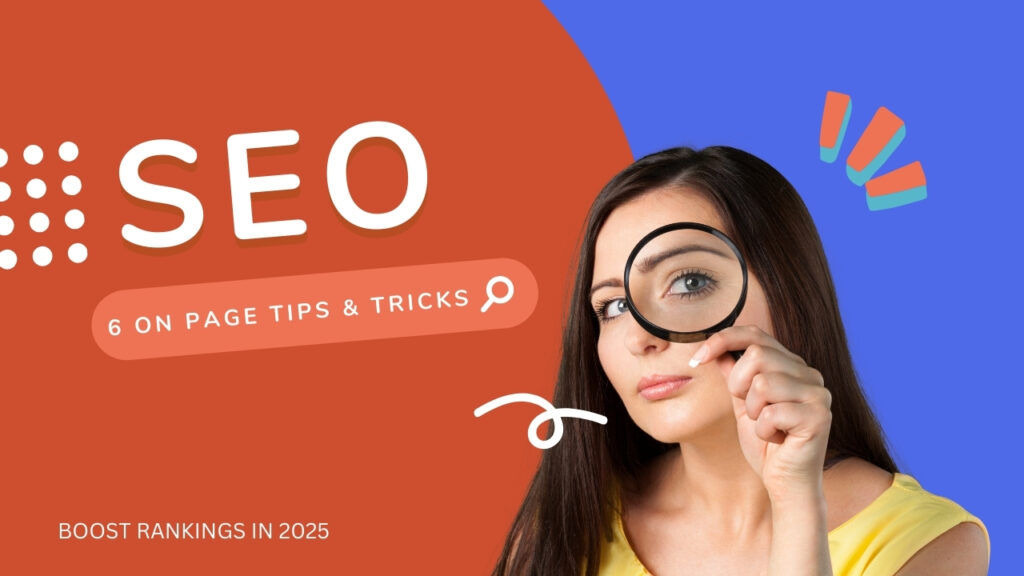Introduction to On-Page SEO in 2025
Search engine optimization is evolving faster than ever, and on-page SEO remains the backbone of every successful digital strategy. While backlinks and domain authority carry weight, your website’s content quality, structure, and user experience directly influence rankings. In 2025, with Google’s AI-driven updates, websites that fail to optimize their on-page elements risk falling behind.
Why On-Page SEO Still Matters
Despite advances in off-page ranking factors, on-page optimization gives you the most control. From keyword targeting to UX design, every adjustment you make helps search engines understand your content while improving visitor satisfaction.
The Role of Google’s Algorithm Updates
Google’s recent updates prioritize helpful content, E-E-A-T (Experience, Expertise, Authoritativeness, Trustworthiness), and page speed. This means SEO isn’t just about keywords anymore; it’s about context, intent, and engagement.
Technique 1: Optimizing Title Tags with Power Words
Your title tag is the first impression users see in search results. In 2025, Google still considers it a primary ranking factor.
Ideal Length and Structure of Title Tags
- Keep titles between 50–60 characters.
- Place your main keyword near the beginning.
- Avoid duplicate titles across multiple pages.
Using Emotional & Action-Oriented Words
Power words like “proven,” “ultimate,” or “boost” improve click-through rates (CTR). A well-crafted title is both SEO-friendly and persuasive, ensuring users choose your result over competitors.
Technique 2: Crafting Compelling Meta Descriptions
Meta descriptions no longer directly influence rankings, but they heavily impact CTR, which indirectly boosts SEO.
How to Increase CTR with Meta Descriptions
- Keep it under 155–160 characters.
- Add a call-to-action (CTA) like “Learn more” or “Discover how.”
- Naturally include your focus keyword.
Common Mistakes to Avoid
- Keyword stuffing.
- Using duplicate descriptions.
- Leaving descriptions blank (Google auto-generates unappealing snippets).
Technique 3: Strategic Keyword Placement
Keyword strategy has shifted toward contextual optimization. Google’s NLP (natural language processing) allows it to understand synonyms and related terms.
Keyword Density vs. Keyword Stuffing
- Maintain a keyword density of around 1–1.5%.
- Prioritize readability over rigid keyword insertion.
- Use variations and synonyms instead of repeating exact phrases.
LSI Keywords and Semantic Search
Latent Semantic Indexing (LSI) keywords help Google understand content depth. For example, in an article about “SEO,” related terms like rankings, search intent, algorithms, and backlinks enhance relevance.
Technique 4: Header Tag Optimization (H1–H6)
Headers don’t just structure your content; they tell Google how to interpret it.
Structuring Content for Readability
- Use only one H1 per page (your main topic).
- Break content into logical H2 and H3 subheadings.
- Ensure each section flows naturally for both users and search engines.
The Importance of Subheadings for SEO
- Subheadings improve scannability.
- They allow for keyword placement without overstuffing.
- Google often uses H2 and H3 tags for featured snippets.
Technique 5: Image Optimization & Alt Text
Visuals are critical for engagement, but unoptimized images can slow down your site.
Reducing Page Load with Compressed Images
- Use formats like WebP or AVIF for faster load times.
- Compress images with tools like TinyPNG or ShortPixel.
- Implement lazy loading for non-critical visuals.
Writing Descriptive and SEO-Friendly Alt Text
Alt text is essential for accessibility and SEO.
- Describe the image accurately.
- Include a relevant keyword naturally.
- Avoid “keyword dumping.”
Technique 6: Internal Linking Strategies
Internal links pass link equity and guide visitors through your content.
Creating a Logical Link Structure
- Prioritize pillar pages (comprehensive guides).
- Link to related blog posts for deeper exploration.
- Use breadcrumbs for easier navigation.
Anchor Text Best Practices
- Use descriptive anchors (e.g., SEO best practices vs. click here).
- Avoid over-optimization with exact-match anchors.
- Keep links relevant to the surrounding content.
In 2025, on-page SEO is about more than keywords-it’s about experience, structure, and engagement. From title tags to Core Web Vitals, every optimization step improves both search engine visibility and user satisfaction. Remember: Google rewards websites that prioritize people, not just algorithms. If you’re looking for personalized strategies to implement these techniques and take your website to the next level, partnering with an experienced SEO expert in Kerala can make all the difference. With proven freelance SEO services, I help businesses boost rankings, increase organic traffic, and stay ahead of the competition in 2025 and beyond.


